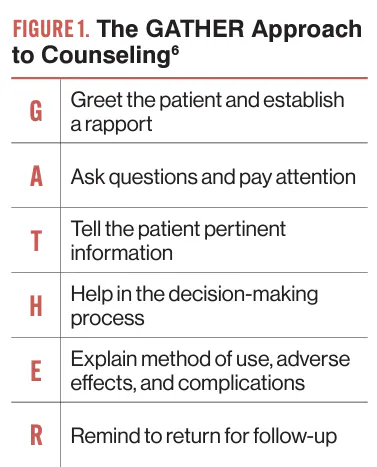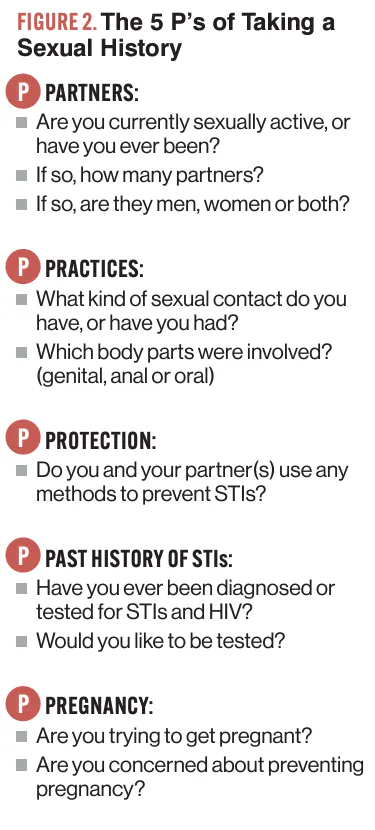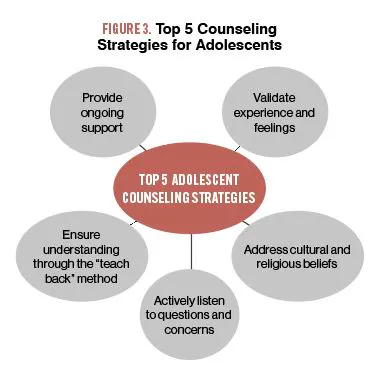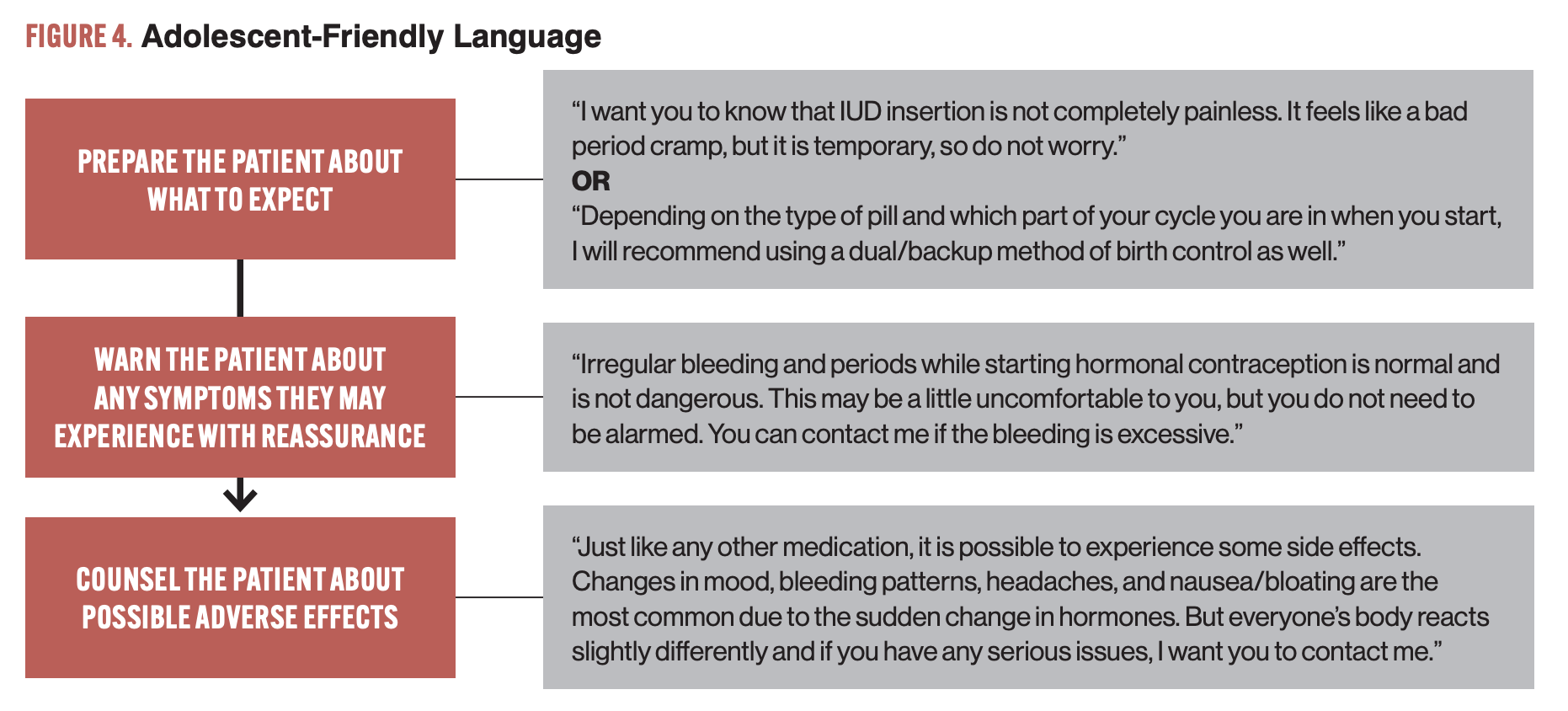How to help adolescents choose the right contraceptive
Discover effective counseling techniques and overcome barriers to empower adolescents in making informed decisions about contraception, fostering trust, confidentiality, and autonomy in reproductive health care.
How to help adolescents choose the right contraceptive | Image Credit: © JPC-PROD - © JPC-PROD - stock.adobe.com.

INTRODUCTION
Adolescence, the transition period between childhood and adulthood, is a unique time when young people question, explore, and experiment in all aspects of life, including dietary habits, personal relationships, substance use, and sexual activity. In the United States, an estimated 55% of male and female teenagers have had sexual intercourse by age 18, according to a 2017 report by the CDC’s National Center for Health Statistics.1
Although adolescent pregnancy rates have been on a decline since their peak in the 1990s, the current rate in the United States, 15.4 per 1000 females aged 15 to 19 years, is the highest among developed countries.2 Compared with the United States, Europe has a much lower adolescent pregnancy rate despite having a similar rate of sexual activity. This can be attributed to Europeans’ wider access to sexual health education and contraception.3
The higher rate of adolescent pregnancies in the United States also may be partially due to the lower rate of long-acting reversible contraceptives (LARCs) use in this population. Data have shown that LARCs such as the intrauterine device have higher efficacy, continuation rates, and satisfaction compared with short-acting contraceptives such as oral contraceptive pills (OCPs). Though they are an excellent choice for adolescents, in the United States, only 4.3% of adolescent females who are using contraceptives choose a LARC.3
Although contraceptive use at first intercourse has increased over the years, between 2011 and 2015, condoms remained the most popular pregnancy prevention method among teenagers (97%), followed by withdrawal (60%) and birth control pills (56%).1 Despite these data, many adolescents still do not use any method of contraception at first intercourse and show irregular subsequent use.1,4
Improving adolescent-centered counseling and care
Counseling is an intimate and interactive process between the patient and the health care provider. Counseling for adolescents differs from that for adults and requires an individualized approach, accounting for cognitive development, peer influence, familial influence, and media exposure that may contribute to personal preferences.
Motivational interviewing is a counseling technique used to encourage patients to adopt new, healthy habits. This strategy uses open-ended questions to identify the gap between current actions and desired behaviors. Motivational interviewing in sexual and contraceptive counseling allows for an open discussion about the patient’s long-term goals and accessible contraceptive options, which facilitates the decision-making process.
When discussing contraception with adolescents, it is crucial to focus on building trust and confidence. Creating a safe and nonjudgmental space ensures that adolescents feel supported and comfortable expressing their thoughts and concerns. The Contraceptive CHOICE project, a retrospective cohort study done in St. Louis, Missouri in 2006 included contraceptive counseling that started with warmly greeting the patient, having a judgment-free demeanor, and using open-ended questions to get more insight into the normal life of the teen. After building rapport, the discussion of contraception would begin.5
The GATHER strategy is a type of motivational interviewing technique that emphasizes informed decision-making and has been studied in the setting of contraceptive counseling. The key elements of the GATHER strategy are described in Figure 1.6

Active listening and validation play a significant role in fostering trust. Actively listening to adolescents’ thoughts, questions, and concerns goes a long way in establishing trust and rapport between the health care provider and the adolescent. Addressing cultural and religious beliefs is also important. Finding ways to bridge potential gaps by providing information that aligns with their cultural or religious perspectives is invaluable.
The CDC recommends obtaining a sexual history that covers the 5 P’s: partners, practices, protection from sexually transmitted diseases, past history of sexually transmitted infections (STIs), and prevention of pregnancy (Figure 2). The information obtained with this technique allows the provider to assess the patient’s risk level and subsequently develop a contraceptive strategy that caters to the individual’s needs.3

Next, it is important to determine the patient’s understanding in order to effectively counsel them. Start by asking the patient what they already know about contraception and sexual health. Using age-appropriate language, models, and videos is useful for explaining contraceptive options and their associated adverse effects.
Providing accurate and comprehensive information is vital. Providers should always offer evidence-based and reliable information about contraception while addressing common myths and misconceptions (Figure 2). Questions should be encouraged, and understanding should be ensured using the “teach back” method.
Follow-up and ongoing support are essential to sustain trust and confidence. Adolescents should be made aware that they can reach out for further questions or concerns even after the initial conversation. Offering resources such as websites, educational materials, or support groups provides ongoing support and access to reliable information.
Teenagers should never be coerced into using contraception or a specific method of contraception. Provider biases regarding adolescents and contraceptives can pose a hindrance to care. Adolescents are eligible for the full range of contraceptives regardless of age, relationship, or marital or childbearing status. In the absence of medical contraindications, adolescents should receive thorough information on each method and its potential adverse effects. Providers must also address and debunk myths and misconceptions about contraceptives such as infertility, acne, and weight gain.
Furthermore, when providing care to younger patients, it is essential to reassure them that they have the autonomy to decide which contraceptive method best suits their body. If obstetrician-gynecologists do not believe they can provide the reproductive care their patients desire, they have a responsibility to promptly refer those patients to other health care professionals. See Figure 3 for strategies to use when counseling adolescents.

Barriers
Various factors can hinder adolescents’ access to contraceptive methods, including societal or cultural stigmas, financial limitations, health care provider attitudes, and health care system challenges. Common barriers to contraceptives include inconvenient clinic hours, transportation issues, financial constraints, lack of confidentiality, and inadequate provider training.7
Health care providers play a crucial role in addressing these challenges. Helping with access can range from holding clinics after school hours to acquiring the necessary skill sets and knowledge to deliver unbiased, nonjudgmental, evidence-based, and adolescent-friendly sexual and reproductive health care.
Results of the Contraceptive CHOICE Project showed that providing free contraceptives, along with comprehensive counseling, to adolescents translated into a decrease in unintended pregnancies and abortions. The CHOICE Project results also showed that when the cost is no longer a limitation, the majority of adolescents would choose LARC methods.8
Adherence to a method of contraception can be difficult for adolescents.9 Only 12% of teenagers continue taking OCPs after 1 year, making them less likely than adult women to follow OCP regimens.10 Therefore, follow-up visits are highly recommended because they help maximize adherence to all methods of contraception and promote and reinforce healthy decision-making. Regularly scheduled contraceptive follow-up visits can help address problems regarding adherence, adverse effects, and complications that may arise. Providers should also reassess relationships, sexual behaviors, and contraceptive needs, as well as assess the need for STI surveillance and prevention.
Early counseling
Early counseling can be an effective strategy for adolescent contraception. According to the results of one study, females who started having sex aged 14 years or younger were less likely to have used a method of contraception at first sex and took longer to start using contraception. Therefore, obstetrician-gynecologists must initiate the conversation around contraception preemptively to help teens have better outcomes; sexual activity is not a prerequisite for discussing or offering contraceptives.11
It is important to regularly assess the need for contraceptives at primary health care visits for adolescents by taking a thorough history and asking pertinent questions. Early counseling aims to address any misunderstandings, such as underestimation of fertility, pregnancy ambivalence, and accessibility to or eligibility for contraceptives.12 Longer appointments for adolescents will allow the health care professional to provide comprehensive, adolescent-centered counseling and address all of their concerns.13 Counseling empowers adolescents to make informed decisions, develop healthy behaviors, and establish positive relationships—ultimately promoting their overall well-being.
Trust, consent, and confidentiality
Confidentiality concerns can be a barrier to adolescents receiving appropriate care. Ensuring confidentiality is important for contraceptive counseling because it creates a space for adolescents to discuss sensitive topics and behaviors safely and privately. Research suggests that some adolescents will not seek care if their confidentiality is not assured.14 A study conducted by Reddy et al revealed that 59% of adolescents seeking contraception said they would not seek care if they had to inform a parent.15
Confidentiality laws vary by state; 24 states and the District of Columbia explicitly allow all minors to consent to contraceptive services and STI testing and treatment without parental permission.16 It is imperative for obstetrician-gynecologists to research their state and local laws and act accordingly. Regardless of laws, health care providers can still counsel and educate minors on contraceptive options, even if parental consent is required for the actual provision of contraceptives.17 Therefore, there should be a dedicated time for conversation between the health care provider and adolescent patient without any parent or guardian present. Assure adolescents that the conversation will remain confidential unless there are major safety concerns.
CONCLUSION
Effectively counseling adolescents about contraceptives involves employing active listening, empathy, and shared decision-making. Providers can build trust and promote open communication by creating a supportive and safe space that maintains the privacy of the adolescent. Utilizing motivational interviewing techniques and asking pertinent open-ended questions can help adolescents express their feelings and goals.
Providing information using age-appropriate, adolescent-friendly language (Figure 4) and allocating enough time to address any misconceptions and concerns are crucial. Lastly, ongoing follow-up and support can ensure that adolescents consistently make informed decisions about their reproductive health.

This article was initially published in the January/February issue of our sister publication, Contemporary OB/GYN®.
References:
1. Abma JC, Martinez GM. Sexual activity and contraceptive use among teenagers in the United States, 2011-2015. Natl Health Stat Report. 2017(104):1-23. https://www.cdc.gov/nchs/data/nhsr/nhsr104.pdf
2. US Department of Health and Human Services Office of Population Affairs. Trends in teen pregnancy and childbearing. Accessed August 10, 2023. https://opa.hhs.gov/adolescent-health/reproductive-health-and-teen-pregnancy/trends-teen-pregnancy-and-childbearing
3. Committee Opinion No. 710: counseling adolescents about contraception. Obstet Gynecol. 2017;130(2):e74-e80. doi:10.1097/AOG.0000000000002234
4. Black A, Yang Q, Wu Wen S, Lalonde AB, Guilbert E, Fisher W. Contraceptive use among Canadian women of reproductive age: results of a national survey. J Obstet Gynaecol Can. 2009;31(7):627-640. doi:10.1016/s1701-2163(16)34242-6
5. Potter J, Santelli JS. Contraceptive counseling for adolescents. Womens Health (Lond). 2015;11(6):737-741. doi:10.2217/whe.15.75
6. Rinehart W, Rudy S, Drennan M. GATHER guide to counseling. Popul Rep J. 1998(48):1-31.
7. Todd N, Black A. Contraception for adolescents. J Clin Res Pediatr Endocrinol. 2020;12(suppl 1):28-40. doi:10.4274/jcrpe.galenos.2019.2019.S0003
8. McNicholas C, Madden T, Secura G, Peipert JF. The contraceptive CHOICE project round up: what we did and what we learned. Clin Obstet Gynecol. 2014;57(4):635-643. doi:10.1097/GRF.0000000000000070
9. Levy S. Contraception and adolescent pregnancy. July 2022. Updated September 2022. Accessed August 10, 2023. https://www.merckmanuals.com/professional/pediatrics/problems-in-adolescents/contraception-and-adolescent-pregnancy
10. Zibners A, Cromer BA, Hayes J. Comparison of continuation rates for hormonal contraception among adolescents. J Pediatr Adolesc Gynecol. 1999;12(2):90-94. doi:10.1016/s1083-3188(00)86633-4
11. Finer LB, Philbin JM. Sexual initiation, contraceptive use, and pregnancy among young adolescents. Pediatrics. 2013;131(5):886-891. doi:10.1542/peds.2012-3495
12. Higgins JA, Popkin RA, Santelli JS. Pregnancy ambivalence and contraceptive use among young adults in the United States. Perspect Sex Reprod Health. 2012;44(4):236-243. doi:10.1363/4423612
13. Committee Opinion No. 676: health literacy to promote quality of care. Obstet Gynecol. 2016;128(4):e183-e186. doi:10.1097/AOG.0000000000001714
14. Ford CA. Which adolescents have opportunities to talk to doctors alone? J Adolesc Health. 2010;46(4):307-308. doi:10.1016/j.jadohealth.2010.01.014
15. Reddy DM, Fleming R, Swain C. Effect of mandatory parental notification on adolescent girls’ use of sexual health care services. JAMA. 2002;288(6):710-714. doi:10.1001/jama.288.6.710
16. Guttmacher Institute. Minors’ access to contraceptive services. Accessed August 10, 2023. https://www.guttmacher.org/state-policy/explore/minors-access-contraceptive-services
17. Confidentiality in adolescent health care: ACOG Committee Opinion, Number 803. Obstet Gynecol. 2020;135(4):e171-e177. doi:10.1097/AOG.0000000000003770
Having "the talk" with teen patients
June 17th 2022A visit with a pediatric clinician is an ideal time to ensure that a teenager knows the correct information, has the opportunity to make certain contraceptive choices, and instill the knowledge that the pediatric office is a safe place to come for help.